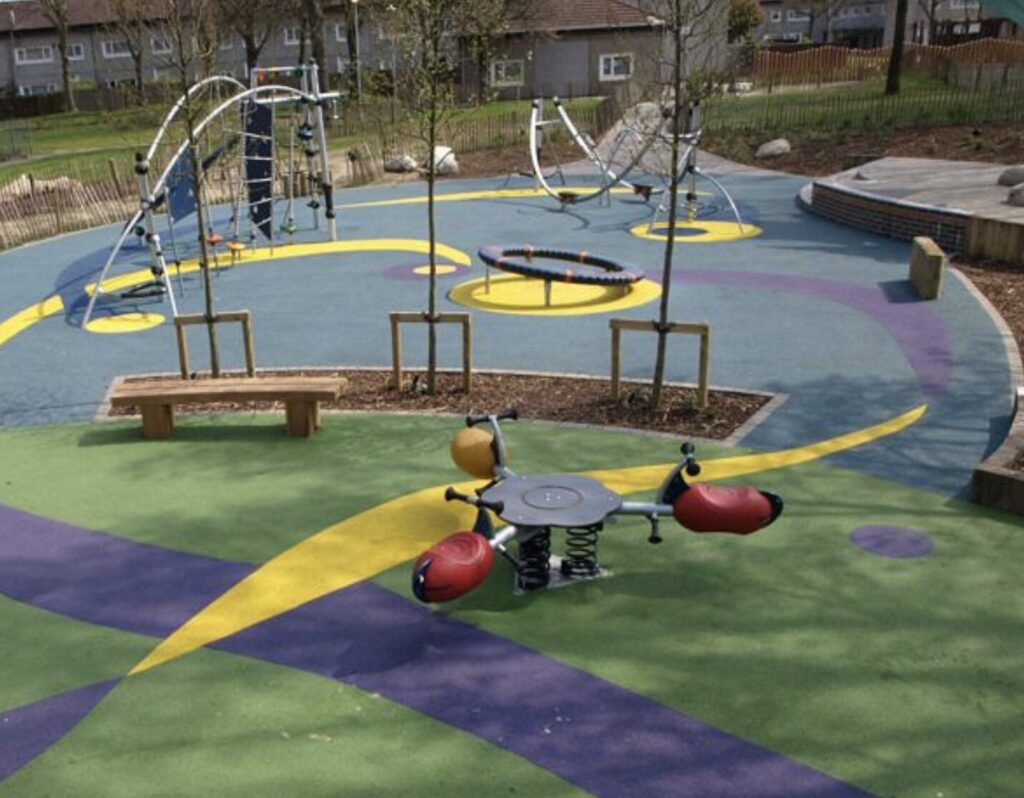Public Comment: Please Deny Permitting for Poured in Place Rubber Surface at New Fort River School

Poured-in-Place rubber playground surface. Photo: Wikimedia Commons (CC BY 2.0 Deed)
The following public comment was submitted in writing for the meeting of the Amherst Conservation Commission on March 13, 2024.
My understanding is that permitting for the playground surface material at the new elementary school will be back on an upcoming agenda of the Amherst Conservation Commission. I appreciated your consideration of the materials I had sent you previously expressing concerns about the possible use of rubber poured in place (PIP).
As you had noted, when this issue was last before you, rubber PIP is made using crumb rubber from old tires and contains numerous chemicals that are hazardous to both humans and the environment, including aquatic organisms. The proposed site for the installation of this playground surfacing would mean that this material would have an impact on abutting wetlands and riverfront area, with stormwater drainage into the adjacent Fort River. Since your last meeting, the Amherst Board of Health has considered this building material from a public health viewpoint and advised against its use in this project. As part of their work, the Director of the Health Department (Kiko Malin) spoke directly with the co-authors of the Toxic Use Reduction Institute’s (TURI) report on playground surfacing (Rachel Massey and Lindsey Pollard). Amherst Board of Health member Professor Timothy Randhir, from the UMass Amherst Department of Environmental Conservation, provided a review of the most recent literature on the subject and the board unanimously approved the following motion:
“Under Massachusetts General Law, the Amherst Board of Health has the responsibility for the protection of the public’s health and the protection of the environment from damage and pollution. Following the precautionary principle of public health that states that a product, an action or a policy has a suspected risk of causing harm to the public or to the environment, protective action should be supported before there is complete scientific proof of risk. The board advises that the new school building committee avoid or limit the use of materials that contain heavy metals, polyaromatic hydrocarbons, microplastics, or other components known to be harmful to children and the environment in the playground surface. These chemicals are known to be found in recycled tires. Therefore, the Amherst Board of Health does not support the use of crumb rubber derived from recycled tires in the construction of the new playground at this time.”
The site design for this project has taken great pains to provide for proper stormwater management. Grading and subsurface drainage will direct water away from the building, the outdoor structures (including the playground), and the athletic fields and toward the periphery of the site where wetlands, the Fearing Brook (to the south), and the Fort River (to the east) will receive this runoff. This will include leachates from the nearly 15,000 square foot surface as well as particulate matter, including microplastics, that are released as the playground surface degrades over time. The science on crumb rubber and its constituents continues to emerge (for example, the amount of PFAS it contains has just begun to be studied), but there is already ample evidence of multiple toxic substances (heavy metals, phthalates, volatile organic compounds, polyaromatic hydrocarbons, 6PPD quinone) as well as microplastics. These are known to pose risks of carcinogenicity and endocrine disruption to humans and have negative impacts on wildlife. Attached, is a list of some of the available literature on the chemical contents, their release into the environment, and organismal impacts.
The Elementary School Building Committee has continued to explore alternatives to rubber PIP for the playground surface, including Corkeen which is a poured in place product that contains cork rather than shredded, used tires. While engineered wood fiber (EWF) also avoids the chemicals found in rubber PIP, the building committee has expressed a strong preference for a unitary surface (i.e. PIP) to provide maximum accessibility. All surfaces must meet safety standards (ASTM 1292F) for the fall heights of the equipment that will be chosen. Corkeen provides the necessary safety and accessibility and avoids the concerning chemicals found in rubber PIP.
I hope that the Conservation Commission will deny permitting for the use of crumb rubber in the form of rubber PIP for the new elementary school at the Fort River site. There is sufficient evidence of risk to the population of primary users (children aged 5-12 years old) as well as to organisms in the wetlands, riverfront, and river. An alternative exists (Corkeen) that can provide the necessary safety and accessibility.
Maria Kopicki is a resident of Amherst’s District 5.

Editor’s note: At the March 14 meeting of the Amherst Conservation Commission, the commission unanimously recommended that poured in place (PIP) rubber surface not be used for the playground at the new elementary school at Fort River. Because of the hazards to the Fort River watershed of some of the components of the PIP material which is made from recycled tires, the commission recommended materials made of cork, engineered wood, sand, or wood chips be used instead. The Elementary School Building Committee will need to return to the Conservation Commission for approval of the playground material chosen. The Commission previously approved the plan for the school, excluding the playground material.